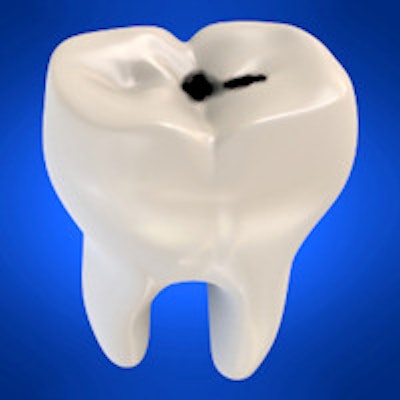
Is there a treatment that could arrest caries without traditional drilling and filling? According to a study presented at the recent International Association for Dental Research (IADR) meeting in Seoul, South Korea, there is: silver diamine fluoride (SDF).
Silver diamine fluoride is an inexpensive topical treatment that is used extensively internationally to treat dental caries. In 2014, the U.S. Food and Drug Administration (FDA) classified SDF as a fluoride.
"This study shows the high value that SDF topical application has to arrest caries independent of the presence of water fluoridation," Steven Duffin, DDS, who was not associated with the study, told DrBicuspid.com. "Since it is the silver component that is bactericidal, this is not surprising."
Dr. Duffin, who is based in Keizer, OR, is a longtime advocate of SDF. His experience using SDF on an off-label basis in his general practice was cited in a 2012 study in the Journal of the California Dental Association (November 2012, Vol. 40:11, pp. 852-858).
Fluoridated vs. nonfluoridated water
The study compared the effectiveness of annual applications of an SDF solution for inhibiting root caries among residents who live in communities with fluoridated drinking water and those who live in nonfluoridated areas. Presenter Edward Lo, BDS, PhD, and colleagues compared residents of Hong Kong, which has community water fluoridation (CWF), with residents in a nonfluoridated area, Guangzhou, a port city northwest of Hong Kong. Dr. Lo is a professor of dental public health at the University of Hong Kong.
“This study shows the high value that SDF topical application has to arrest caries independent of the presence of water fluoridation.”
The study group included 533 healthy residents who had a total of 138 root surfaces with active caries. Among the Hong Kong group, 260 people had 84 root caries lesions; the Guangzhou group included 273 people with 54 root caries lesions.
The subjects were divided into two groups: A control group received annual applications of soda water, while a test group received annual applications of a 38% SDF solution. Oral hygiene instructions and fluoridated toothpaste were provided to all subjects. Their dental root surfaces were calibrated at baseline and every six months.
After 18 months, just over half (75) of these lesions were reviewed, including 51 residents of Hong Kong and 24 in Guangzhou.
The researchers found that 32% of the Hong Kong group who received applications of soda water (control) had active lesions that had stopped, while 75% of those with an annual application of SDF saw their caries halted (p < 0.05). In the nonfluoridated area, Guangzhou, the results were more dramatic: 11% of the control group had arrested caries, while 87% in the SDF group had caries that had been stopped (p < 0.05).
Annual applications of 38% SDF can stop root caries, but CWF levels have no statistically significant influence on the effectiveness of SDF, the researchers concluded. The clinical trial is ongoing and longer-term results will be reported.
Good for students
Silver diamine fluoride is particularly suitable for children who are being treated in school-based programs who have more carious lesions than can be treated in one visit, according to a 2016 paper.
The systematic review was done after SDF was cleared by the FDA for marketing as a class II medical device to treat tooth sensitivity. The researchers from the University of California, San Francisco (UCSF) discussed the off-label use of SDF as a drug to treat and prevent dental caries.
Public health dentists who pushed for FDA clearance for SDF are now applying for a dental caries indication, the UCSF researchers noted.
"From the viewpoint of science, these studies move us closer to an understanding of what is actually happening in the complex disease that is caries," Dr. Duffin said.



















